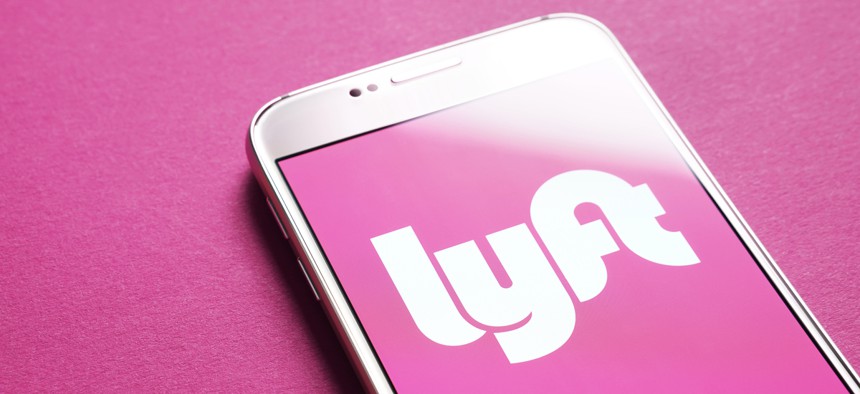Sometimes, Lyft Wants You to Take Public Transit

Shutterstock/Tero Vesalainen
Like its rival Uber, the ride-hailing company wants to be a one-stop mobility shop that integrates buses, trains, subways, and scooters.
Since it launched in 2012, Lyft has gone head-to-head with virtually every other form of urban transportation. Along with arch-competitor Uber, the ride-hailing service has nudged travelers out of taxis and rental cars, drawn pedestrians and cyclists into its backseats, and lured commuters off buses and trains. Competition with other modes has aided the immense growth of the ride-hailing market: In 2018, Lyft’s bookings surpassed $8 billion.
But according to president and co-founder John Zimmer, there’s only one mobility mode that Lyft truly wishes to defeat: the private automobile. Towards that goal, today the company launches a new version of its app aimed at helping commuters more easily give up their car keys. In certain North American cities, dockless scooters, shared bikes, car rentals, and public transit options will now appear next to vehicle rides on the Lyft platform. Time and cost comparisons will also show up on the menu.
“For so long, the car itself had all the real estate in the app, but now we’re putting these other forms front and center,” Zimmer said in an interview with CityLab. “We think this will help open minds to the idea of ‘transportation as a service,’ which sets the stage for a major decline in car ownership.”
Here, Zimmer invoked the Finnish-born concept of “mobility as a service,” or MaaS, the increasingly buzzy pursuit of a universal app that travelers can use to source, compare, and purchase trips across multiple modes. Currently, getting around without a car often requires the multimodal urban traveler to bounce between several interfaces—Google Maps, transit kiosks, Lyft app, bike locks, credit card, and so forth.
The thinking is that a single, highly convenient platform that reduces that hassle could make it that much easier to leave the car at home, or to give up a car entirely. This would be a good thing for cities: Research by UC Berkeley’s Transportation Sustainability Research Center shows that with fewer personal vehicles comes less driving and greenhouse gas emissions.
In one sense, it’s logical that Lyft customers should be able to select from multiple modes in one place, since the company now offers so many of them. Its recent expansions in dockless scooters, bikeshare systems, and short-term car rentals (currently only available in California) are signs of its ambitions to be a one-stop mobility provider. As evidence of the success of these investments, Zimmer said, one in eight Lyft rides took place on a bike or scooter this summer, across the dozens of cities where Lyft currently operates those modes. New York City’s CitiBike, the largest docked bikeshare system in North America (which is now owned by Lyft), hit record daily ridership earlier this month.
Not all would agree that the ride-hailing company, which went public earlier this year, has enjoyed unalloyed success in its forays into micromobility. In San Francisco, Washington, D.C., and Chicago, the company has struggled to keep e-bikes in commission due to safety issues related to their manufacturing. Uber, which also provides dockless bikes and scooters, pulled Jump bikes from several U.S. cities earlier this month, due to low ridership and increased local regulations. It, too, launched a multi-modal version of its app earlier this year.
While Uber has rolled out in-app ticketing for public transit in Denver, Lyft has not yet reached that level of integration. But according to Zimmer, 80 percent of U.S. public transit routes are now visible in his company’s app, along with the cost of riding them. And, using a combination of route data provided by public agencies, and Lyft’s own predictive software, Lyft users will now be able to watch, on-screen, where and when transit vehicles will be arriving. “Now you’re literally going to see the magic of the Lyft car pulling up, but it’ll be the the bus or subway car arriving,” said Zimmer.
Zimmer has long touted the notion that his company’s services would speed the doom of private car ownership: “By 2025, owning a car will go the way of the DVD,” he predicted in 2016. So far, at least, there isn’t much evidence to support that idea. And in the meantime, Uber and Lyft appear to have contributed to significant increases in vehicle traffic in major U.S. cities. Lyft and Uber have also been shown to draw travelers off of public transit—one University of Kentucky study from earlier this year found that for every year ride-hailing operated in a U.S. city, bus ridership fell by an average 1.7 percent.
Showing customers the way back to the bus stop, Zimmer suggests, might lose the company a few fares, but it’s in keeping with Lyft’s longer-term vision. “When you change the interface of the app,” he said, “that’s a commitment to those other modes.”
Laura Bliss is CityLab’s West Coast bureau chief.
NEXT STORY: Beyond Sticker Shock: Experts Urge Congress to Rethink Infrastructure Priorities





